Australia/Israel Review
Remembrance
May 12, 2005 | Jeremy Jones
The Legacy of John Paul II
By Jeremy Jones
When plans were underway for the first visit to Australia by Pope John Paul II, in 1986, the Vatican made an unprecedented offer to the Australian Jewish community.
During the Sydney leg of the visit, time would be specifically allocated for dialogue between the Executive Council of Australian Jewry and the Pontiff, with formal presentations to be made by each party.
From the viewpoint of 2005, it might seem surprising that, less than two decades ago, there was as much apprehension as enthusiasm from Australian Jewry.
But in 1986 the Vatican had no diplomatic relations with Israel, Church antisemitism may have been decreasing but was still very much of concern, painful memories of the Shoah and the Vatican’s ambiguous relationship with Nazism were held deeply by many Jewish Australians, the targeted evangelising of Jews by Christians was high on the community agenda and the behaviour of the Vatican in international politics was an ongoing source of contention.
The historic relationship between Catholics and Jews, from the Jewish perspective, had been dominated by the teaching and preaching of anti-Jewish contempt, with many Holocaust survivors in Australia having experienced first-hand the criminal and brutal behaviour of “Christian Europe”.
The widely-held view in the Jewish community was that Christians viewed Christianity as the successor to Judaism, with the religion of Jewish people both false and superceded. On the other hand, interfaith dialogue in Australia was beginning to move out of the shadows, in large part due to the activities of the nuns of the Sisters of Sion, who in turn were guided by the Vatican.
After a vigorous and passionate debate, those who wanted the meeting to proceed prevailed, with the Pope’s historic visit to the Rome Synagogue subsequently taking place before the Pontiff’s trip to Australia and his meeting with nine Jewish Australians.
The atmosphere was formal and proper, with the speeches by Leslie Caplan and by Pope John Paul II careful yet powerful statements of principle. Both presentations were steeped in the hope that the dialogue would lead to a changed relationship between Catholics and Jews. I was the youngest member of the Jewish contingent and at the meeting’s conclusion the Pope made a point of telling me that I lived in revolutionary times in the history of the relationship between our Faiths.
Nine years later, at Sydney’s Domain, I was Judaism’s representative at a multi-faith welcome for the Pope, during his 40-hour stop-over. He again singled me out to talk about young people and particularly young Jewish people having a special mission to work for humanity.
When news of the John Paul II’s passing was received by Jewish communities around the world, there was undeniable, almost tangible, grieving at the loss of a man who had changed the face of the relationship between Jews and Catholics.
The Pope’s visit to Israel, his pronouncement of many injunctions against not only antisemitism but supercessionism, the progress made towards a better understanding of the Nazi Holocaust, the Shoah, and his inauguration of a new era in multi-faith initiatives means he will leave a remarkable legacy.
In a 1980 address to the Jewish community of Mainz, Germany, John Paul spoke of Judaism as “the Old Covenant, never revoked by God.”
Earlier, on his 1979 visit to Auschwitz, when he approached the inscriptions bearing the names of the countries whose citizens had been murdered there, he said:
“I kneel before all the inscriptions bearing the memory of the victims in their languages. In particular, I pause before the inscription in Hebrew. This inscription awakens the memory of the people whose sons and daughters were intended for total extermination. It is not permissible for anyone to pass by this inscription with indifference.”During his visit to Israel in 2000, he placed a note in the Western Wall, Judaism’s holiest site, with an apology for Church antisemitism written on it.
He also visited Yad Vashem, Israel’s memorial to the victims of the Holocaust, where he movingly paid his respect to those victims.
The Vatican’s 1998 document on the Shoah, despite a number of short-comings, was an important milestone in the reconciliation process between the Church and the Jewish people.
It is true that there were times I, and the Jewish world, did not agree with the Pope, such as when he met with then Austrian President Waldheim; in critical areas relating to Catholic understanding of the relationship between the church and the Shoah; and in the Vatican’s relationship with the Iranian and some Arab dictatorships.
However, Pope John Paul II achieved more in terms of transforming relations with the Jewish people than any other figure in the history of the Catholic Church, building on the platform of his predecessor in understanding Jewry, Pope John XXIII.
In the two thousand year history of the papacy, no previous Pope has had, let alone, demonstrated, such an interest in seeking reconciliation with the Jewish people.
Pope John Paul II built a sound platform for further progress in the crucial area of inter-faith reconciliation and understanding between Jews and Catholics.
In May 2003, John Paul hosted a delegation from the World Jewish Congress, where he outlined a vision for relations between Jews and Catholics. “In light of the rich common religious heritage we share, we can consider the present as a challenging opportunity for joint endeavours of peace and justice in our world,” he said. “This sort of practical cooperation between Christians and Jews requires courage and vision.”
It is to be hoped that his successors follow his inspirational example in this area, and that relations between Jews and the Church continue to mature and prosper.
Tags: Australasia






